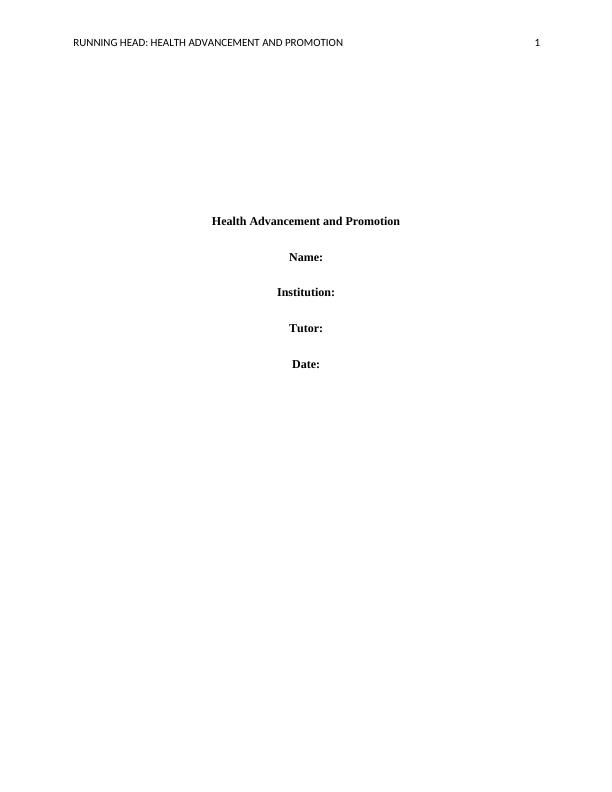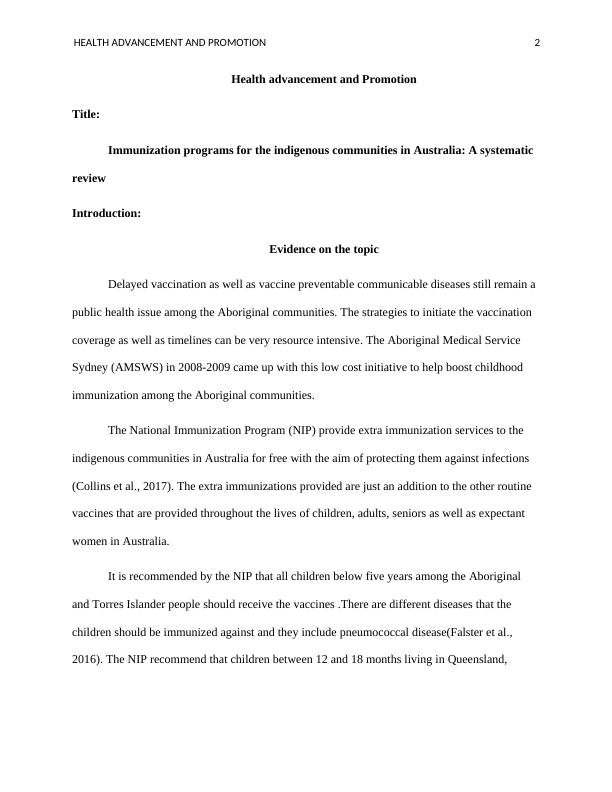Immunization Programs for Indigenous Communities in Australia: A Systematic Review
Added on 2023-06-05
10 Pages2063 Words81 Views
RUNNING HEAD: HEALTH ADVANCEMENT AND PROMOTION 1
Health Advancement and Promotion
Name:
Institution:
Tutor:
Date:
Health Advancement and Promotion
Name:
Institution:
Tutor:
Date:

HEALTH ADVANCEMENT AND PROMOTION 2
Health advancement and Promotion
Title:
Immunization programs for the indigenous communities in Australia: A systematic
review
Introduction:
Evidence on the topic
Delayed vaccination as well as vaccine preventable communicable diseases still remain a
public health issue among the Aboriginal communities. The strategies to initiate the vaccination
coverage as well as timelines can be very resource intensive. The Aboriginal Medical Service
Sydney (AMSWS) in 2008-2009 came up with this low cost initiative to help boost childhood
immunization among the Aboriginal communities.
The National Immunization Program (NIP) provide extra immunization services to the
indigenous communities in Australia for free with the aim of protecting them against infections
(Collins et al., 2017). The extra immunizations provided are just an addition to the other routine
vaccines that are provided throughout the lives of children, adults, seniors as well as expectant
women in Australia.
It is recommended by the NIP that all children below five years among the Aboriginal
and Torres Islander people should receive the vaccines .There are different diseases that the
children should be immunized against and they include pneumococcal disease(Falster et al.,
2016). The NIP recommend that children between 12 and 18 months living in Queensland,
Health advancement and Promotion
Title:
Immunization programs for the indigenous communities in Australia: A systematic
review
Introduction:
Evidence on the topic
Delayed vaccination as well as vaccine preventable communicable diseases still remain a
public health issue among the Aboriginal communities. The strategies to initiate the vaccination
coverage as well as timelines can be very resource intensive. The Aboriginal Medical Service
Sydney (AMSWS) in 2008-2009 came up with this low cost initiative to help boost childhood
immunization among the Aboriginal communities.
The National Immunization Program (NIP) provide extra immunization services to the
indigenous communities in Australia for free with the aim of protecting them against infections
(Collins et al., 2017). The extra immunizations provided are just an addition to the other routine
vaccines that are provided throughout the lives of children, adults, seniors as well as expectant
women in Australia.
It is recommended by the NIP that all children below five years among the Aboriginal
and Torres Islander people should receive the vaccines .There are different diseases that the
children should be immunized against and they include pneumococcal disease(Falster et al.,
2016). The NIP recommend that children between 12 and 18 months living in Queensland,

HEALTH ADVANCEMENT AND PROMOTION 3
Northern Territory, Western Australia and South Australia should be immunized with the
additional booster dose of the pneumococcal vaccine.
The NIP also provide two doses of the Hepatitis A vaccine which is usually provided 6
months apart .It is recommended for children as from 12 months and should be provided to all
the indigenous communities children living in Queensland, Northern Territory, Western
Australia and the South Australia (Fathima et al., 2017). However, the age at which the
pneumococcal and the Hepatitis A vaccines are provided vary among the four regions. The Flu
vaccine is also provided by the NIP to all the Aboriginal and Torres Islander children between
the age of 6 months and 5 years.
Children between the age of 5 and 9 years are usually provided with catch up
vaccines .This are the routine vaccines that the children missed at a certain stage of their lives.
This is the same case for children between 10 and 15 years (Gidding et al., 2018) .Besides the
catch up vaccines to this age group, The Human papilloma virus, tetanus, diphtheria and the
whooping cough vaccines are also provided.
Adults among the indigenous communities are also not exempted from the catch up
vaccines. Adults between the age of 15 and 49 years receive the catch up vaccine from the NIP.
Some of the vaccines at this group include flu (Influenza) for people above 15 years (Hendry et
al., 2018). Pneumococcal vaccine is also provided to people within this age group. Those adults
above 50 years within the Aboriginal and Torres Islander people are also immunized against the
pneumococcal disease.
Northern Territory, Western Australia and South Australia should be immunized with the
additional booster dose of the pneumococcal vaccine.
The NIP also provide two doses of the Hepatitis A vaccine which is usually provided 6
months apart .It is recommended for children as from 12 months and should be provided to all
the indigenous communities children living in Queensland, Northern Territory, Western
Australia and the South Australia (Fathima et al., 2017). However, the age at which the
pneumococcal and the Hepatitis A vaccines are provided vary among the four regions. The Flu
vaccine is also provided by the NIP to all the Aboriginal and Torres Islander children between
the age of 6 months and 5 years.
Children between the age of 5 and 9 years are usually provided with catch up
vaccines .This are the routine vaccines that the children missed at a certain stage of their lives.
This is the same case for children between 10 and 15 years (Gidding et al., 2018) .Besides the
catch up vaccines to this age group, The Human papilloma virus, tetanus, diphtheria and the
whooping cough vaccines are also provided.
Adults among the indigenous communities are also not exempted from the catch up
vaccines. Adults between the age of 15 and 49 years receive the catch up vaccine from the NIP.
Some of the vaccines at this group include flu (Influenza) for people above 15 years (Hendry et
al., 2018). Pneumococcal vaccine is also provided to people within this age group. Those adults
above 50 years within the Aboriginal and Torres Islander people are also immunized against the
pneumococcal disease.

End of preview
Want to access all the pages? Upload your documents or become a member.
Related Documents
National Immunization Program Presentation 2022lg...
|1
|648
|30
Immunisation For Health Practitioners Assignmentlg...
|15
|2041
|52
Immunisation for Health Practitioners (306)lg...
|12
|1550
|45
VACCINATION SCHEDULE.lg...
|1
|418
|20
Main Public Health Issues Related to Immunisation in Australialg...
|5
|940
|25
immunisationlg...
|4
|376
|44
